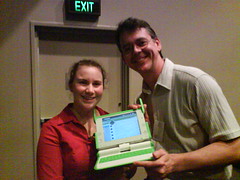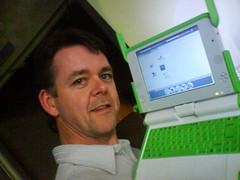I occasionally feel a little guilty. Although I am very much committed to the idea that technology should be integrated, no, more than that, embedded, into what happens in a classroom on a day-to-day basis, the truth is that I have spent many years teaching computing as a discipline in its own right. And I have to keep telling myself that that’s ok, that there are still many kids who have a deep interest in technology for the sake of technology and find the very nature of computing highly engaging as a stand alone topic. So I’m cool with that. It’s ok to be a geek.
I believe one mark of a good teacher is to be able to take complex ideas and simplify them without making them simple. For example, there are a couple of concepts in the realm of computing that are not really all that hard to understand but can be very hard to explain. Binary numbers can be one. Vector graphics another.
 So I was really impressed when I saw VectorMagic, a somewhat geeky (yet very cool) web app put together by James Diebel and Jacob Norda from the Stanford University Artificial Intelligence Laboratory. I blogged a couple of thoughts about EPS files and vector graphics the other day and in the comments I was pointed to VectorMagic by Kathy Nann. What an amazing tool! Thanks Kathy!
So I was really impressed when I saw VectorMagic, a somewhat geeky (yet very cool) web app put together by James Diebel and Jacob Norda from the Stanford University Artificial Intelligence Laboratory. I blogged a couple of thoughts about EPS files and vector graphics the other day and in the comments I was pointed to VectorMagic by Kathy Nann. What an amazing tool! Thanks Kathy!
I won’t blather on about the need for vector graphics and when you should use them… I blathered enough about that in that other post, so go read that if you dare.
What VectorMagic does is to take a bitmapped image (jpg, gif, bmp, etc) and trace the shapes contained within them in order to to convert them into vector outlines. This gives a remarkable crispness to the image at any resolution. Vector images don’t get blocky and full of artifacts as they get bigger. They just recalculate how to draw that shape a bit bigger using a nice sharp edge. I’m so glad I found this tool and I know I will get lots of use out of it. (Well, maybe not lots, but just knowing its there and what it can do makes it all worth it.
But the other thing that really struck me is just how good this sort of application is as a teaching tool. Because of the way it steps through the process and how it asks the user for questions about the image, it makes it so much clearer as to the real differences between bitmap and vector graphics. It even places them next to each other at the end, and lets you zoom and pan in real time to inspect the two image types. Visually, this is a really powerful way to learn about a concept that can be otherwise quite nebulous and hard to explain, and after using Vector Magic to convert a few images it would be hard NOT to understand the difference.
And it got me thinking about just how much we can use the the intuitive and malleable nature of software to assist us in explaining and investigating tricky ideas. Programs like VectorMagic are amazing in the way they can be used to visually demonstrate the bitmap/vector concept. Trying to explain sound waves to junior students can be hard, but when theses students can create, see and manipulate waveforms directly using Audacity it makes it much more concrete. Playing whatif games with spreadsheets, tracking data visually using Gapminder, directly manipulating the globe with Google Earth or creating 3D models with SketchUp… these tools make it almost trivial to convey what used to be challenging and hard-to-grasp ideas.
All of this should pave the way for us to help kids come up with better questions, and make better use of this new information. I’m going to try harder to make these tools do the jobs that they are good at, so that I can spend more quality time working with kids on the thinking skills that really matter.
Tags: tools, vector, higherorder, thinking, software


